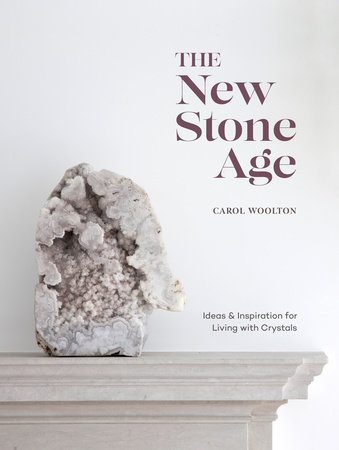Introduction The color of every crystal is unique, depending on its individual journey and the environment in which it was formed. Most are found buried in the earth’s crust or in gravel weathered away from larger rocks. Nature’s upheavals are responsible: vast geological shifts, volcanic eruptions, the sinking of continents, and erosion of mountains give these crystal survivors an aura of magic. Time is important. When molten rock cools quickly, tiny crystals form. A slower cooling, combined with enough space inside of hollows and cavities, allows larger crystals to grow.
We describe crystals as growing, because over time they do. They branch and spike, in what appear like subterranean gardens, as more atoms connect with each other in orderly repeated geometric patterns. This perfect symmetry mimics nature’s other phenomena, such as snowflakes, the whorls of a petal, or a butterfly’s wings. At the same time, their colors remind us of the beauty of nature and that something bigger and stronger exists beyond us. People talk of them as being alive, because their inner color can alter, appearing to fire up or fade depending on the light and time of day. Even weather patterns can effect changes, making a crystal appear almost animated.
Over the centuries, the shiny geometric structure of crystals has accrued a unique combination of history, geological knowledge, and spiritual properties. The latter are being rediscovered to help with today’s challenges. It seems ironic that as contemporary life advances at a quickened pace, collectively, we are emulating the behavior of ancient cultures, seeking the reassuring sense of permanence and natural beauty that a crystal, with its deep connection to Mother Earth, can provide. In spite of living in an exciting era of innovation, with limitless technology and information at our fingertips, the changing social, economic, and political climates feel like a gathering storm propelling us to use these stones—as our ancient ancestors did—as a purposeful shield for daily life.
Many millennials have rejected their forebears’ practice of wearing jewels as status symbols. Ornamentation for this generation is more personal rather than a type of symbolism to proclaim their particular group or tribe. The era of “fake news,” insecurity induced by social media, ill-paid employment, and expensive housing has made crystals a comforting touchstone they can trust. Young people share crystal obsessions in a quasi-religious way on Instagram and create sleek crystal glossary apps to download and use as a meditation.
The stones have a connection with the earth that provides comfort and purpose, fulfilling a human desire for something meaningful beyond the self. The realization of the effects of human behavior on the environment is powering a global objective to save the planet along with new appreciation of the physical treasures the earth produces.
Created eons ago, crystals represent a grander intention of honoring the earth, as well as promoting our own small, private goals. There is a moral value, too, in eschewing a synthetic man-made material in favor of crystal. It’s a battle of our times, lending a young crystal-wearing generation the air of warriors as they struggle to change behavior toward the earth.
In ancient Egyptian culture, honoring the feminine was an important principle—one we are now looking back to emulate. “The inclusion and elevation of women correlate with the signs of a healthy society,” writes philanthropist Melinda Gates in her 2019 book,
The Moment of Lift: How Empowering Women Changes the World. Goddesses were held in every bit as much esteem as male gods, and the high status of females is visible in the cultural artifacts they left behind. Women and girls in the developed world may be healthier, better educated, and more autonomous than in any previous age but our fight for equality isn’t over. We have a new set of complex issues to deal with that have no equivalent in the past.
The ancients used stones to activate their consciousness—to feel the full capacity of their senses in order to navigate their “earth experience” and perceive realms beyond death. Some Egyptologists believe the ancients’ search for enlightenment gave them a heightened sense of perception—in the same way we visit the gym, they exercised their “sense muscles” on a daily basis, using stones and crystals to learn to live well, with a lighter heart.
Four thousand years ago, the ancient Egyptians mined crystals in valleys east of the Nile to satisfy their demand for colorful stones such as malachite, garnet, hematite, turquoise, and carnelian, which they were convinced were beneficial. They trusted that placing crystals on the body would release a healing energy onto wounds and attributed a practical purpose to each stone. Night terrors? Topaz was the cure. Carnelian purified the blood. Small amulets of red jasper treated infertility. Malachite was crushed into an alluring green kohl, which shaded and protected the eyes. Turquoise was popular as a sign of joy. Lapis lazuli, imported from Afghanistan, was reminiscent of the heavens, creation, and rebirth. The intense blue stone would be ground and rubbed into the crown of the head to draw out spiritual impurities. Much later, Cleopatra used emeralds mined near the Red Sea and rose quartz in a bid for eternal youth.
Ancient Egyptians equated the process of refining a crystal to spiritual purification. When a stone was cut and the rough exterior removed, its gleaming soul was revealed. We can only imagine the heart-lurching chemical reaction experienced by the first person to stumble across a crystal glinting from the soil, a piece of magic borne from the earth’s crust. Under those circumstances, believing the stone to have sacred powers would have been inevitable. It would have been only a small step to believe one could harness this power by adorning oneself with it.
The belief that crystals are silent protectors, capable of sustaining their daily life, echoes down the centuries in a way that is relevant for modern life. The ancients had a profound connection to nature—which our city-led civilization has lost, to our collective detriment—that can be regained in the depths of a crystal.
The desire for ritual endures. Every human from birth shares a common quest for meaning, and repeated patterns of behavior can be important for our security, comfort, and sense of belonging.
I can’t fully explain the energy of a crystal itself, but I can explain certain emotions that people experience as they come to think of themselves in new ways. You could argue that the inexplicable happenings I and others have witnessed around crystals are simply a case of chance and coincidence, but nonetheless they were real experiences. The aim of a crystal is to foster a deeper feeling of happiness and fulfillment. There’s no scientific double-blind experiment that can testify to that, but we do have the “case study” results of life trajectories that have changed for the better—some of which are included in the chapters that follow.
Sadly, crystals aren’t magic spells. There are no miracles or “cures.” You can’t tuck a rose quartz, known as the supporter of all forms of love, underneath your pillow to guarantee finding
the one. But working closely with a stone, and charging it with your intentions, can lead to balance and mental clarity. Your ability to determine what sparks joy in life might be sharpened, and you might find yourself considering what matters most, which will include relationships. The quartz can help illuminate what you need to discard, as you gradually clear out old toxic emotions to help yourself sleep better.
Everyone can tap in to crystal power. And this renewed faith in crystals is gaining momentum as we collectively seek an improved rhythm of life and define what it means to be a modern human being. There is but one single rule: you need to work earnestly with your crystal. Life improvements can happen, but as with all relationships, it works best when you make a commitment. There might not be just one stone that’s perfect for you. Like me, you might require different crystals at different moments. Think of this book as part of your rainbow tool kit for better living, because the ultimate goal of using any crystal is to feel free.
Copyright © 2020 by Carol Woolton. All rights reserved. No part of this excerpt may be reproduced or reprinted without permission in writing from the publisher.








